EXPLORE: Earth's Water (BrainPop)
| Site: | Mountain Heights Academy OER |
| Course: | Earth Science Q4 |
| Book: | EXPLORE: Earth's Water (BrainPop) |
| Printed by: | Guest user |
| Date: | Saturday, 26 July 2025, 9:58 AM |
Description
global h2o distibution
1. READ: Where is Water Found?
Earth's hydrosphere is composed of many reservoirs, places where water is stored. Water is an overlapping component of each of earth's spheres - the biosphere, geosphere, and atmosphere all contain water. Earth's water is stored in clouds, oceans, ice caps & glaciers, lakes, rivers, living organisms, soil, and as groundwater.The largest of earth's reservoirs is the ocean. In fact, 97% of all the water on our planet can be found in the oceans. Only 3% of our planet's water is freshwater - water that can be used by living things. Most of the planet's freshwater is trapped in glaciers, ice caps, or underground aquifers. Only a small amount of freshwater is found on Earth's surface as lakes and rivers, yet this is the source for most of the water people use every day.
How long a molecule of water will stay in one of these reservoirs is known as its residence time. Water will stay in some reservoirs for a long period of time; for example, groundwater and ice sheets typically have long residence times. Water does not typically spend a long time in the atmosphere before it condenses and falls back to the earth as precipitation, so this particular reservoir has a short residence time. Soil also has a short residence time because water is readily lost to evaporation or easily seeps into the ground.
2. EXPLORE: Water in the Atmosphere
Very small amounts of water occur in the atmosphere. Water stored in the atmosphere accounts for only 0.001% of the planet's total water. Water exists in the atmosphere in all three phases, depending on temperature and altitude in the atmosphere. It exists as clouds, precipitation, and water vapor.Humidity is a measure of the amount of water vapor in the air.
Sources: http://ga.water.usgs.gov/edu/earthgwlandsubside.html and Teachers' Domain, Cloud Types, published October 21, 2005, retrieved on June 9, 2010, http://www.teachersdomain.org/resource/ess05.sci.ess.watcyc.cloudtype/
3. READ: Water in the Biosphere
While the cells of living organisms are made primarily of water, the biosphere is not a large reservoir. However, the water stored in living organisms is essential for cells to operate. Thousands and thousands of different organic chemicals, proteins, amino acids, carbohydrates, and so forth are dissolved within the water in the cell.
The processes of photosynthesis and cellular respiration both use water. Remember, photosynthesis is the process by which plants produce energy - in the form of glucose - for an ecosystem. And respiration is the chemical process by which organisms consume the glucose and release energy needed by their cells to stay alive and perform their functions. In photosynthesis, water in the atmosphere is combined with sunlight and carbon dioxide in the plants' chlorophyll, and converted into energy. In respiration, water is given off as a byproduct and stored in the cells.
4. EXPLORE: Water in the Geosphere
Water is stored in the geosphere as glaciers & ice caps, lakes, rivers, streams and wetlands, in the soil, and as groundwater. Surface water (lakes, streams, rivers, etc.) only accounts for 0.3% of our planet's freshwater. Approximately 30% of Earth's freshwater is stored as groundwater, but the majority (approximately 69%) is locked up in glaciers and ice caps. The amount of water stored in glaciers changes over time, due to changing climate patterns. Warming temperatures have dramatically altered several glaciers, which you can explore in the images below.
http://pbs.panda-prod.cdn.s3.amazonaws.com/media/assets/wgbh/ess05/ess05_int_glaciers/index.htm
5. VIEW: Groundwater (BrainPop)
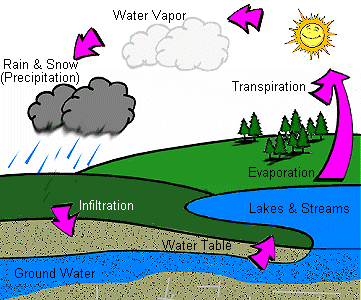
Groundwater is recharged by precipitation falling and infiltrating the soil. Photo courtesy of the Department of Natural Resources.
Groundwater is water stored underground, in the pore spaces of rocks and soil. While groundwater does not make up a large percentage of the Earth's total water, it does account for approximately 30% of Earth's freshwater. Not all of earth's groundwater is fresh, but groundwater located beneath land surfaces - where freshwater (which falls as precipitation) seeps into the ground - typically is.
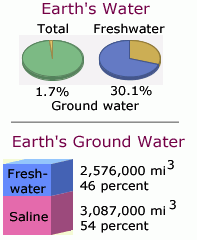
Chart showing that 1.7% of Earth's total and 30% of its freshwater is groundwater, as well how much of Earth's groundwater is saline vs. fresh. USGS.
Where does it come from & why is it important?
Groundwater comes from precipitation seeping through the soil. An aquifer is an underground layer of permeable rock, from which groundwater can be easily extracted using a well. Groundwater is located in the zone of saturation, where all of the available spaces in the rock and soil is filled with water. Above this zone is the zone of aeration, where pore spaces are filled with both water and air; we are unable to pump water from this zone. Between the zones of aeration and saturation lies the water table, the top surface layer of groundwater.
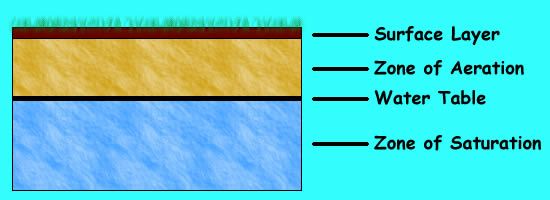
Diagram showing relative locations of zones underground. Image courtesy of Michigan Technological University.
Groundwater is an important reservoir because many people rely on water collected from aquifers. For example, the Ogallala aquifer, which underlies the Midwestern part of the United States, provides the majority of the region's drinking water and is an important source of water for irrigating crops.
6. VIEW: Groundwater Depletion
Natural and human activities can cause groundwater depletion. Groundwater levels can change naturally over time due to changes in weather patterns, precipitation amounts, stream flow, and geologic processes such as erosion. However, the largest contributor to groundwater depletion is pumping from wells. If water is withdrawn from the ground at a faster rate than it is recharged by precipitation, the water table will drop.
There are several negative effects of groundwater depletion:
- Lowering of the Water Table: or water to be pumped from a well, the well must reach below the level of the water table. If the water table is lowered too far it would have economic consequences for well owners. Depending on the characteristics of the rock layer the groundwater is located in, impacts to the water table may be short- or long-term, and the water level may fall only a small amount or hundreds of feet. Excessive pumping can lower the water table so much that wells dry up and can no longer provide water.
- Reduces water in streams & lakes: generally, a large amount of the water flowing into a stream or river comes from groundwater seeping into the riverbed. Pumping groundwater can therefore alter the movement of water between an aquifer and surface water or wetland, influencing aquatic and wetland habitats.
- Land subsidence: as water is removed from rocks and soil, it creates instability and causes the ground to sink. In the United States more, than 17,000 square miles in 45 states have been directly affected by subsidence, most of which is attributed to excessive pumping of groundwater.
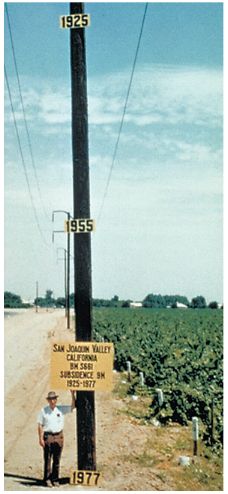
Land in the San Joaquin Valley, California dropped 9 meters (29.5 feet) between 1925-1977 as a result of groundwater depletion. Image courtesy of Wikimedia.
Sources: http://ga.water.usgs.gov/edu/watercyclegwstorage.html, http://ga.water.usgs.gov/edu/earthgwlandsubside.htmland http://ga.water.usgs.gov/edu/gwdepletion.html
7. READ: Utah's Reservoirs
People in Utah rely on water stored in both groundwater (obtained from springs and wells) and surface water reservoirs.
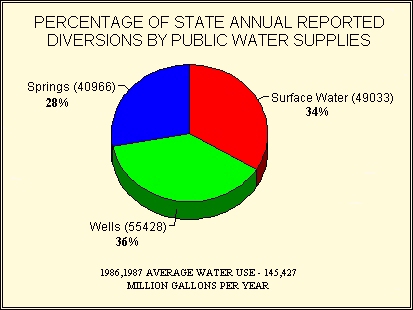
Chart showing Utah's water sources.
Each spring, snowmelt helps recharge underground aquifers. The state has an elaborate system of man-made reservoirs which are used to hold water from streams and rivers to distribute for usage. The major rivers that provide water for consumption in northern Utah are: Provo, Weber, Bear, Ogden, Jordan, and Spanish Fork. Water from these major rivers is stored in several reservoirs scattered throughout northern Utah. Approximate 40% of the drinking and irrigation water used in the northern part of the state comes from water diverted from these major rivers into man-made reservoirs.

Source: http://www.water.utah.gov/brochures/uws_broc.htm
After you have completed this part of the lesson, you can check the box for this lesson piece in the course to mark it as complete

